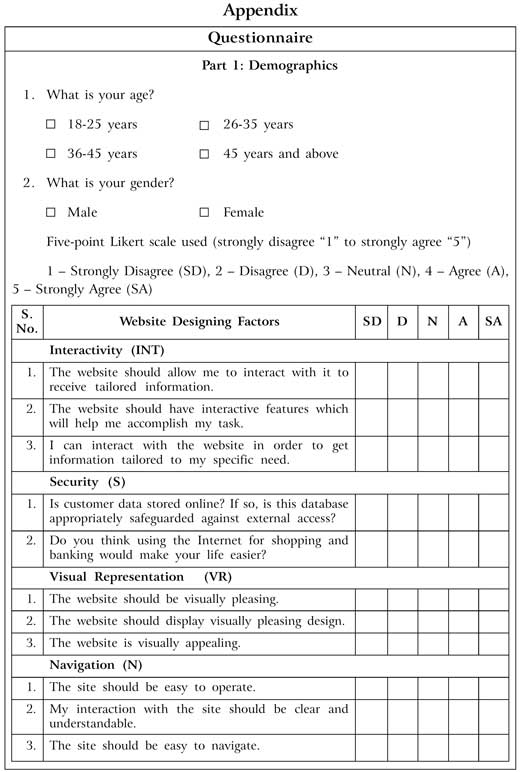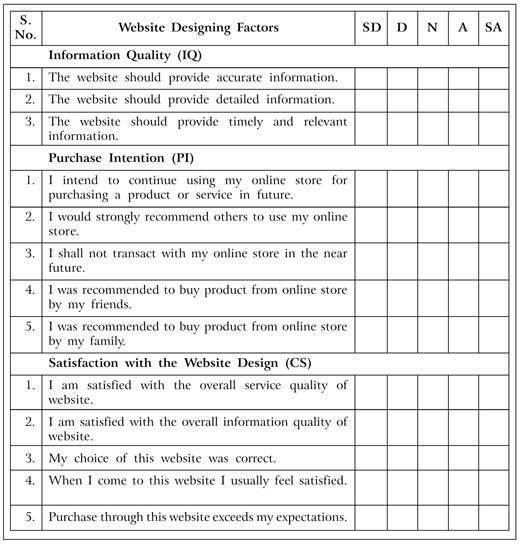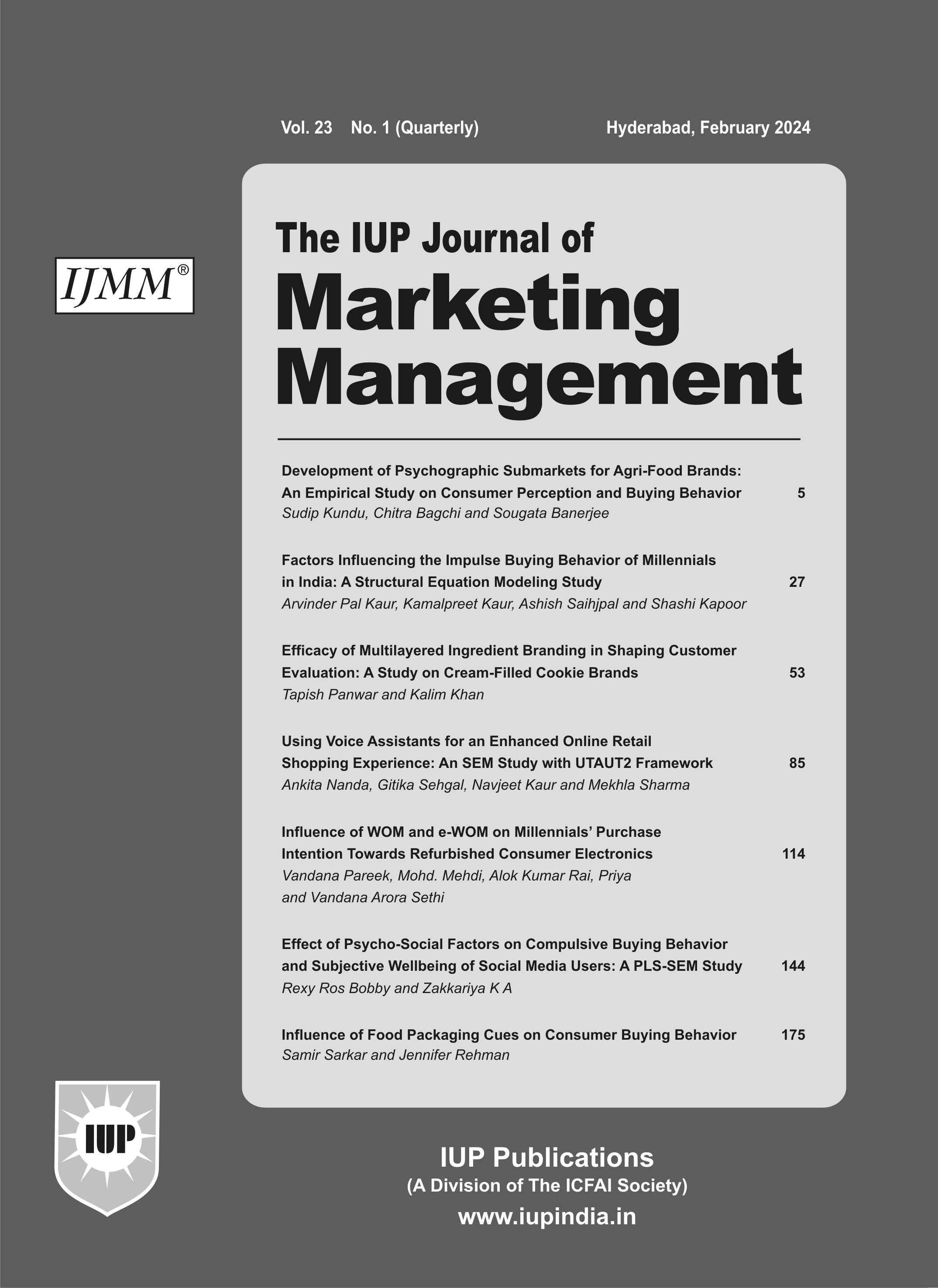
Feb'18
The IUP Journal of Marketing Management
Archives
The Impact of Website Designing Factors on Online Purchase Intention: Evidence from Fashion Brands
Nida Rubab
MS Scholar,
Institute of Business and Management,
University of Engineering and Technology,
Lahore, Pakistan.
E-mail: nidarubab11@gmail.com
Shameem Shoukat
MS Scholar,
Institute of Business and Management,
University of Engineering and Technology,
Lahore, Pakistan.
E-mail: Shameemshoukat336@gmail.com
Muhammad Shaheen
MS Scholar,
Institute of Business and Management,
University of Engineering and Technology,
Lahore, Pakistan.
E-mail: shaheen_mian@hotmail.com
Kamran Yousef Sandhu
Director Research,
Pakistan Readymade Garments Technical Training Institute,
Lahore, Pakistan.
E-mail: Dr.k.sandhu@hotmail.com
This is the age of advertisement. Advertisement is considered a more effective tool for commercial success even in e-markets. The purpose of this study is to explain how website designing factors work and how they attract the customers. Website designing factors influence the online purchase intention in fashion brands, especially women-centric brands. To conduct this study on online shopping, advertisement convenience sampling method has been used and the total sample size was 384. The data has been analyzed using the research technique PLS-SEM. The results of the study show that some website designing factors like Interactivity, Security and Information Quality are valuable methods to attract the customers, generating awareness among the customers, besides providing information to the viewers. However, at times, website designing is unsuccessful in building the perception of the viewers for purchasing the product. The findings of the study are especially relevant to those situations where the marketers are planning to launch their products and also where it is expected that the commercials will be viewed only once. Further, the study is limited to fashion brands and can be expanded to other brands.
Introduction
The Internet has become an important part of human life. It has become a familiar place for people to converse with others, do bank dealings, shop online and so on (Leu et al., 2004). Especially, the online marketing applications utilized by the companies and the online shopping trends have gained popularity worldwide, providing many advantages for both the companies and the consumers. Online shopping has many advantages and hence its popularity (Brown and Duguid, 2017). Electronic web-based shopping systems are fast replacing conventional, face-to-face systems.
Online shopping is growing rapidly, even though not as pervasively as expected. Consumers browse brands on electronic and web-based media. Thus, online shopping influences the consumers' feelings, attitudes and moods towards buying. Online purchase has become more flexible and convenient. However, this is also much riskier than brick- and-mortar shopping. In an online shopping context, atmospherics are subsumed in the computer boundary. So far little is known about how this crossing point affects consumers' purchase intention.
Consumers can evaluate and shop from a number of online shopping stores, and there is no traveling cost involved while shopping online. According to Wakefield and others, the success of a retail website is determined by the extent to which the design of the website creates a positive experience among consumers and help them accomplish their consumption goals (Wakefield et al., 2004). The success of a website design is determined by four design elements, namely, visual design, transactional design, information content and navigation. Design elements attract customers and lead to purchase intention and customer loyalty. This paper discusses what people of diverse age group and gender prefer on a website and the impact of website designing factors on online purchase intention with reference to fashion brands.
Literature Review
Website Design Factors
Website appearance consists of links, texts, images, animation and audio or visual elements. It is a place to convey important messages to web users. The color, text, style and graphics create the overall visual impression of the website. Researchers in the past have claimed that illustration is one of the most important factors that impacts consumers' attitude towards the website. Szymanski and Hise (2000) in a study claimed that website design has a more important role in consumer satisfaction than product variants.
Information design deals with the way information is presented on the site. Information about the firm, products and services offered, various promotional offers, contact information, etc. are essential parts of a website. This is because consumers while visiting a website look for a sequence related to price, product and promotions. Consumers not only investigate the information on the website but also evaluate whether the information available is good and helpful. According to Kim and Niehm (2009), websites which provide useful information and interactive medium help the consumers to purchase, attract and retain. Shankar (2017) found that ease of gathering information and profundity of information on the website have an important positive impact on overall consumer satisfaction level (Shankar et al., 2003; and Shankar, 2017). Researchers have also claimed that sufficient and precise information on the website develops constructive attitude among consumers and increases satisfaction.
Interactivity determines the communication between the web users and the company. In the words of Park and Kim (2000), interaction represents the way the user navigates the webpages with utmost ease. They claimed that interaction between the shopping websites and the consumers has a significant influence on consumers' perception of the website. Literature has also recognized quite a few elements of website interactivity such as keyword search, personalization and customer feedback and has claimed that all these features have a significant impact on consumer satisfaction (Zhao and Roy, 2009). Sudweeks et al. (1998) and Liu (2003) have also acknowledged a significant relationship between website interactivity and consumer satisfaction.
Information security is a very important aspect of World Wide Web. Kearney and Kruger, (2016a and 2016b) aver that information security in organizations is often compromised by the risky behavior of the users.
Risk Perception
According to Forsythe and Shi (2003) and Pavlou (2003) consumers' risk perception is a huge factor in their purchase intention and decision. Online purchase intention is used to reach the goal of actual purchase. Customers' real purchasing conduct is dichotomous in the light of the fact that shoppers either need to buy or do not buy the intended product (Hsu et al., 2015).
Navigation (N)
Navigation design refers to the interface part of the website design and the text and graphic links between pages that designate sequencing between the web pages. A website should have clearly connected paths and easy to follow links so that users can find their way to the products or accurate information that they are seeking. A site ought to provide simple ways to browse with the goal that clients can easily explore and locate the precise data. As claimed by Yoo and Donthu (2001), "No matter how thorough the information content of a site is, a consumer who has difficulty in searching and getting the needed information is likely to leave the site”. According to Nielson (2000) and Nielson et al. (2004), navigation design ought to educate shoppers about his/her present position on the site from where he/she has come and can go on the site. A proper navigation design as per consumers' perceived ease of use positively impacts his/her overall satisfaction with the website. A good navigation design makes it easy for consumers to appreciate the website and use it more comfortably. This further brings good experience and consumer satisfaction.
Mckinney et al. (2002) suggested in their study that an easy to access format of the website is what basically attracts the customers. No matter how informed the site one has created, a consumer who is having trouble locating goods on the website page or attaining information he/she needs, would leave the site because of its cumbersome formatting. A proper navigation design has a positive impact on the consumers satisfaction because of its easy to use mechanism which further brings good experience and results in satisfaction with the website design.
Visual Representation (VR)
Szymanski and Hise (2000) claimed in their analysis that website design helps significantly in the accomplishment of purchaser fulfillment. The textual style helps in creating more prominent consumer loyalty as opposed to having an expansive list of items. It contains messages, pictures and cutting-edge activities and various media components. It is used to pass on the key components of what the site is about. The illustrations and shading help in making an adequate visual impression.
Different studies have affirmed that site configuration and appearance significantly impacts a client's buying intention and in this way brings about aggregate consumer loyalty (Gustafsson et al., 2005). All these elements help in building consumer attitude towards that site and more importantly that particular brand. Rosen and Purinton (2004) distinguished the most essential components that contribute to making a successful website design and giving a solid understanding into the brand itself. Hausman and Siekpe (2009) stated that a stable website incorporates a collection of rich media elements which evoke a constructive outcome from the client. They presumed that the website design is decidedly connected to the purchaser's online buying expectation. Fogg et al. (2002) found that almost 50% of the customers who utilize online stores give careful consideration to the shallow parts of a site, its elements, openness, convenience than to its substance. According to McKnight et al. (2002), a website that is easy to use and provides all the data that a shopper needs to make his/her choice, gives the shoppers satisfaction and fulfillment.
Interactivity (INT)
Park and Kim (2000) in their analysis opined that interaction is the manner by which a buyer can surf the website pages with least or no additional conflict. In their review, they contended that a client's view of the website is impacted by the communication between the specific shopping site and the customer.
Information Quality (IQ)
Information quality is defined as information that is fit for use by data consumers. Information quality is also defined as the information that meets the specifications or requirements. Information has quality if it satisfies the requirements of its intended use (Tuomi, 1999).
Security (S)
Data security is a procedure of Internet security that recognizes the security attention to locality associations. Data security also includes the risky behavior of the users.
Satisfaction with the Website Design (CS)
Satisfaction with the website design can be considered as the final basis in modern marketing; therefore, the success of each business depends heavily on identifying and satisfying the superior customer needs and demands. Satisfaction with the website design can lead to loyalty and positive word-of-mouth advertising (Abdul-Muhmin, 2002). As far as fashion brands are concerned, a positive relationship between satisfaction with the website design and online purchase intention has been well established (Jamal and Naser, 2002). Satisfaction with the website design is measured through consumption and purchase experience (Sharma and Patterson, 2000).
Online Purchase Intention (PI)
Purchase intention can be considered as a person's anticipation to obtaining a precise item which he/she is looking for. Online transitions can be viewed as an action in which the procedure of data recovery, data exchange, and item purchase occurs. The purchase expectation mirrors the users' craving to purchase a brand specifically. Online buy goal, an imperative indicator of real purchasing conduct, alludes to the customer appraisal with respect to site quality, data hunt, and item assessment (Jahng et al., 2001).
Objective
The objective of the study is:
- To explore the impact of website designing factors (navigation, visual representation, information quality, interactivity, security) on online purchase intention.
Research Questions
- What is the impact of Website Designing Factors on Satisfaction with the Website Design?
- What is the impact of Website Designing Factors on Online Purchase Intention?
- What is the impact of Website Designing Factors on Online Purchase Intention with the mediating role of satisfaction with the website design?
Research Hypotheses
The hypotheses tested are as under:
H1 There is a significant relationship between navigation of website design and satisfaction with the website design.
H2 There is a significant relationship between visual representation of website design and satisfaction with the website design.
H3 There is a significant relationship between interactivity of website design and satisfaction with the website design.
H4 There is a significant relationship between information quality of website design and satisfaction with the website design.
H5 There is a significant relationship between security of website design and satisfaction with the website design.
H6 There is a significant relationship between satisfaction with the website design and online purchase intention.
Data and Methodology
Conceptual Framework
Figure 1 shows the proposed model of our paper. It shows the relationship of website designing factors, satisfaction with the website design and online purchase intention.

Theoretical Framework
Online purchase intention is the dependent variable in this study. Website designing factors (navigation, visual representation, interactivity, information quality and security) are independent variables. Mediating variable is satisfaction with the website design. The website designing factors (navigation, visual representation, interactivity, information quality and security) directly or indirectly affect the online purchase intention, as shown in Figure 2. All these variables have significant relationship with each other.
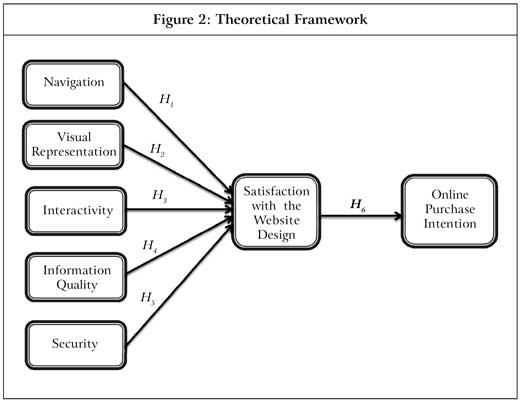
Data
In this study, quantitative survey research method is followed for the analysis of data. Website designing factors are the independent variable which was examined by five substitute variables (navigation, visual representation, interactivity, information quality and security), online purchase intention is dependent variable and satisfaction with the website design is the mediating variable. We used the quantitative research approach; respondents are online purchasers in Lahore City, Pakistan (January 2016 to March 2017). The sample size consists of 384 respondents and data has been collected through a structured questionnaire (Bloemer et al., 1999) by using convenience sampling technique. Collected data has been analyzed using Partial Least Square-Structural Equation Modeling (PLS-SEM).
To ensure that the information provided by the respondents is correct, we included validation items in the research instrument. We used these items to verify that the customers who responded were fully qualified to provide the information we requested.
Depending on the objectives and research questions of the study, primary and secondary sources of data were used. The secondary data was collected from online websites, journal articles, research papers, conference papers and the Internet which discussed the theoretical framework of website designing factors such as navigation, visual representation, interactivity, information quality and security on the online purchase intention. Primary data was collected from customers through a survey questionnaire.
The survey questionnaire contained two parts: Part one describes the respondents' demographic profile including gender and age. The second part contains some descriptive questions under each factor of website designing. In this part, a number of questions, were asked which represent the construct. Interactivity factors consist of three questions, which are taken from Oly and Kok (2005). Security comprises two questions, which are taken from Oly and Kok (2005). Further, one visual representation contains three questions and navigation also comprises three questions, which are taken from Oly and Kok (2005). Online purchase intention comprises five questions which are taken from Oly and Kok (2005). Three questions about information quality and five questions about satisfaction with the website design are taken from Tahir and Abidin (2011) and Bekela (2011) (as cited in Chakiso 2015).
Sampling Technique
We used a structured questionnaire (Bloemer et al., 1999) and also used convenience sampling technique for data collection. Adopting the approach used by Oghuma et al. (2016), we checked the presence of a mediating effect by performing a competing model analysis (Oghuma et al., 2016). First, the direct effects examined the direct relationship between website designing factors and online purchase intention.
Data Analysis Technique
We used PLS-SEM for data analysis. As PLS-SEM supports the reflective measure, sample size 384, theoretical relation and normal data distribution, it is proposed that our study will follow all these assumptions of Partial Least Square.
Measure
For the Website designing factors (WEBST), a five-point Likert scale was used to operationalize the five factors of Navigation (NAVGN), visual representation (VSLREP), interactivity (INTVT), information quality (INFQLY) and security (SEC). This is a scale and the theoretical domain for the scale items was drawn from literature in marketing (Taleghani et al., 2011).
Results and Discussion
Outer Loadings
Outer loading measures constructs indicators or questions factor loading values, which show whether a question is good enough to measure its construct. For this factor loading value should be greater than 0.7. Table 1 shows factor loading values of all elements. In our study, all elements loading value is up to the mark, except PI2 from Online Purchase Intention, and VR1 from Visual Representation; both elements loading values are less than 0.7, so for further analysis we deleted the two questions.
Convergent Validity of the Construct
Reliability and Average Variance Extracted (AVE)
Convergent validity is known as the degree in which all included multiple items are used to measure the same concept (Surienty et al., 2014). It shows that by relying on this data, we can do further analysis and hypothesis testing. For Composite Reliability and Cronbach Alpha, the value of each construct should be greater than 0.7 (Surienty et al., 2014). In our study, both Composite Reliability and Cronbach Alpha of all constructs are up to the mark and values are above 0.7, which shows that the data is reliable. On the other hand, value of Average Variance Extracted (AVE) should be greater than 0.5 (Hair et al., 2014). Table 2 shows AVE values of satisfaction with the website design up to visual representation; each construct value is good enough, which also supports convergent validity and reliability of data.
Discriminant Validity
Discriminant validity shows separate concepts of items and their constructs. As suggested by Surienty et al. (2014) and Hair et al. (2012), for discriminant variability, we use Fornell-Larcker Criterion and Cross Loading. Fornell Larcker value should be greater than 0.6 which is acceptable for each construct (Hair Jr et al., 2016). In our study, Table 3 shows diagonal values of Fornell-Larcker and represents that each construct value is good enough and meets the minimum value criterion which is 0.6.
Cross Loading
The second concept used to measure discriminant validity is cross loading which shows construct element's factor loading values with its own construct and with other constructs (Hair Jr et al., 2016), and its value of each element should be greater than 0.7 with its own construct and less with other constructs. Table 4 shows cross
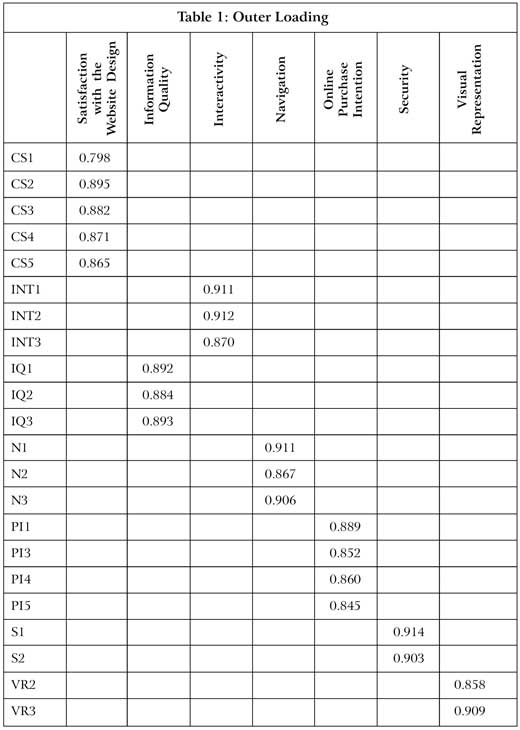
loading values of each construct's elements. All the values are good enough and fulfil the requirement which gives support to our discriminant validity.
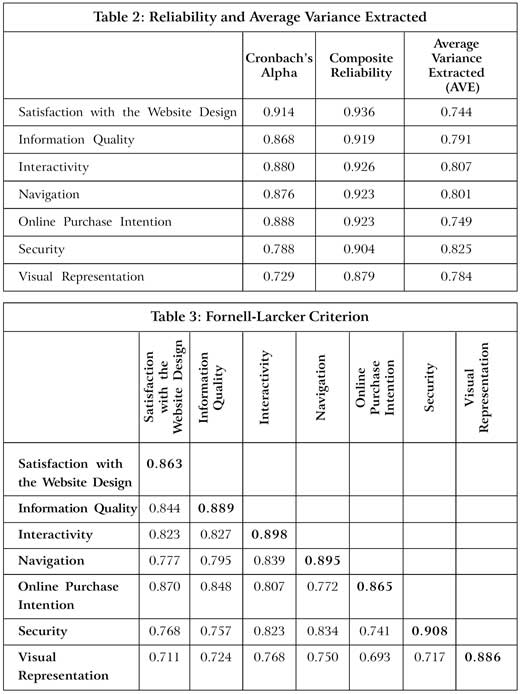
Measuring the Model Fit
R square shows how well the Partial Least Square Regression model predicts our dataset (Surienty et al., 2014). For this model, we used dependent variables values separate in path model. In our path model, there are two dependent variables: satisfaction with the
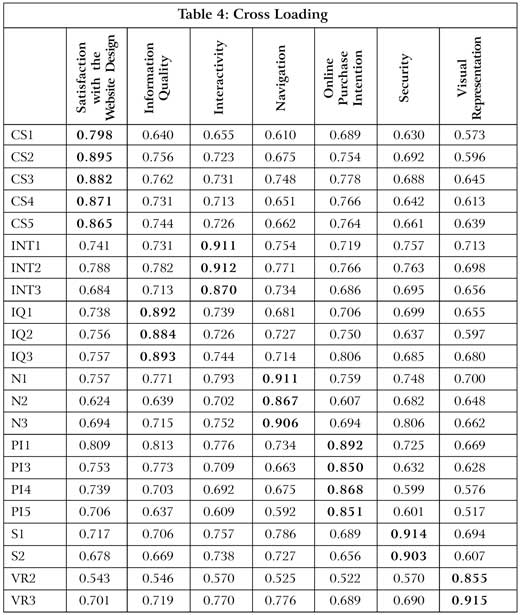
website design and online purchase intention. R2 value should be greater than 0.3 (Hair Jr et al., 2016). Our findings in Table 5 show that the value for satisfaction with the website design is 0.772 and for online purchase intention is 0.757; both values meet the requirement which shows that regression model validates our data.

PLS-SEM Structural Model
Figure 3 represents the relationship between website designing factors and online purchase intention with mediating role of satisfaction with the website design. Outer model represents the factors loading value which should be greater than 0.7 (Hair Jr et al., 2016). In our model, two items have the factor loading value which is less than threshold value; so after deleting those two elements, the above model shows outer loading value that is up to the mark.
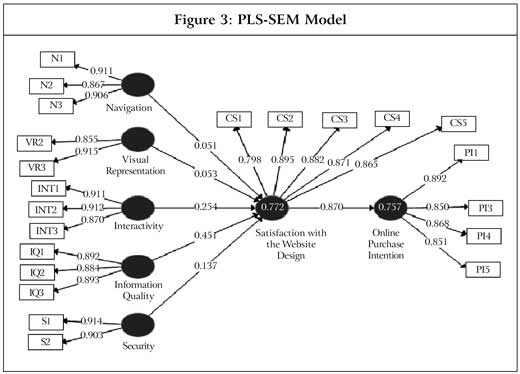
Coming to inner model which represents the impact of exogenous variables on endogenous variable. The value of navigation for satisfaction with the website design is 0.051, which shows that if we increase one unit of navigation, then it will positively affect the satisfaction with the website design by 0.051 units. The value of visual representation for satisfaction with the website design is 0.053, which shows that if we increase one unit of visual representation, then it will positivity affect the satisfaction with the website design by 0.053 units. The value of interactivity for satisfaction with the website design is 0.254, which shows that if we increase one unit of interactivity, then it will positivity affect the satisfaction with the website design by 0.254 units. The value of information quality for satisfaction with the website design is 0.451, which shows that if we increase one unit of information quality, then it will positivity affect the satisfaction with the website design by 0.451 units. The value of security for satisfaction with the website design is 0.137, which shows that if we increase one unit of security, then it will positivity affect the satisfaction with the website design by 0.137 units. At the end, the model represents the significant impact of satisfaction with the website design on online purchase intention. The value for this is 0.870, which shows that one unit change in satisfaction with the website design will increase online purchase intention of consumers by 0.870 units.
The coefficient of determination, R2 for online purchase intention is 0.757, which shows that all six latent variables (navigation, visual representation, interactivity, information quality, security and satisfaction with the website design) explain 75.7% variance in online purchase intention. R2 for satisfaction with the website design is 0.772, which shows that all five latent variables (navigation, visual representation, interactivity, information quality, security and satisfaction with the website design) explain 77.2% variance in satisfaction with the website design.
PLS-SEM Path Analysis
Figure 4 shows the bootstrap results used to test the hypothesis. It shows the graphical representation of t-statistics of each path. Its value should be greater than 1.96 for accepting any hypothesis (Surienty et al., 2014).
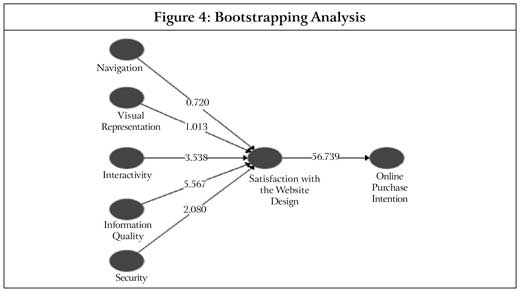
Table 6 shows the path coefficient value by b values, which shows the impact of independent variable on dependent variable. It also shows the t statistics and P value for hypothesis testing. t-statistics should be greater than 1.96, and P value should be less than 0.05 (Hair et al., 2014) which are threshold values for acceptance of the hypothesis.
Table 6 shows the impact of navigation on satisfaction with the website design with b value of 0.051, positive impact, and t statistics is 0.720 and P value is 0.472 and both are not up to the mark, which shows that there is no significant relationship between navigation of website design and satisfaction. So, H1 was rejected.
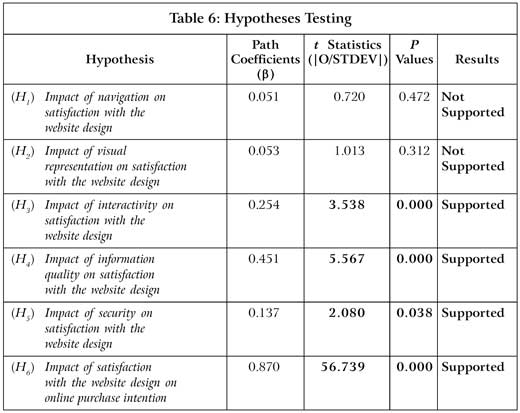
The path coefficient table shows the impact of visual representation on satisfaction with the website design with b value of 0.053, positive impact, and t statistics is 1.013 and P value is 0.312 and both are not up to the mark, which shows that there is no significant relationship between visual representation of website design and satisfaction with the website design. So, H2 was rejected.
The path coefficient table shows the impact of interactivity on satisfaction with the website design with b value of 0.254, showing the higher positive impact, and t statistics is 3.538 and P value is 0.000 and both are good enough to meet the criteria so, there is significant relationship between interactivity of website design and satisfaction with the website design. So, H3 was accepted.
The path coefficient table shows the impact of information quality on satisfaction with the website design with b value of 0.451, showing the higher positive impact on the dependent variable, and t statistics is 5.567 and P value is 0.000 and both are good enough to support the hypothesis. So H4 was accepted which says that there is significant relationship between information quality of website design and satisfaction with the website design.
The path coefficient table shows the impact of security on satisfaction with the website design with b value of 0.137, showing a significant positive impact, and t statistics is 2.080 and P value is 0.038 and both meet the criteria to support that there is significant relationship between security of website design and satisfaction with the website design. So, H5 was accepted.
The path coefficient table shows the impact of satisfaction with the website design on online purchase intention with b value of 0.870, showing the highest positive impact of exogenous variable on endogenous, and t statistics is also too high with value of 56.739 and P value is 0.000 and both are good enough to meet the criteria; so, there is significant relationship between satisfaction with the website design and online purchase intention. This supports our hypothesis, so H6 was accepted.
Conclusion
One of the key and critical components of web-based shopping is shopper fulfillment. Web-based shopping frequencies of the two examples are distinctive; and Lahore city buyers shop online as often as possible when compared to other city buyers. Nowadays, most of the consumers prefer to buy products or services online as against physically visiting a store. For shopping online, potential consumers mostly visit company websites and social networking sites like Facebook. The quality of product information provided online and the security of consumer information are important factors in website designing, and most of the online shoppers do consider these factors. Companies should focus on customer satisfaction because this leads to better online shopping experience. It is beneficial for companies to retain loyal customers instead of trying to find new potential customers as it involves increased spending. Companies should take steps for providing better online shopping experience to consumers, as online shopping is catching up fast in Pakistan.
Limitations and Future Implications
The study covered just one city in Pakistan and considered only online customers. One of the constraints of the study is the sample size utilized in contrast to the aggregate populace of college students in Pakistan. This sample size may not reflect the view of a more extensive population. Another impediment is the element of bias. For instance, respondents could not approach the analysts for prompt help when they were confronted with doubts in finishing the sample. Keeping in mind the end goal to get precise assessment of Pakistani college students' view of online shopping goal, a substantial example estimate, longitudinal review and meetings are suggested for future research.
These change systems can help the analysts to get point by point data and a more profound comprehension of every individual's recognition. This will likewise improve the representativeness of the specimen. What is more, future researchers can concentrate on a bigger segment of Internet user base with a specific end goal to get alternate points of view, for example, the business viewpoint.
Future studies can likewise direct their study comparing different genders (different psychological perceptions), race (cross-cultural study), age group (compare the perceptions of baby boomers and the youth), as well as online shoppers to non-online shoppers, etc. With a specific end goal to better comprehend customers' state of mind and conduct in an unexpected way, additional research is required to analyze other behavioral models or select different factors that may impact buyers' online purchase intention.
References
- Abdul-Muhmin A G (2002), "Effects of Suppliers' Marketing Program Variables on Industrial Buyers' Relationship Satisfaction and Commitment”, Journal of Business & Industrial Marketing, Vol. 17, No. 7, pp. 637-651.
- Bloemer J, De Ruyter K O and Wetzels M (1999), "Linking Perceived Service Quality and Service Loyalty: A Multi-Dimensional Perspective”, European Journal of Marketing, Vol. 33, Nos. 11/12, pp. 1082-1106.
- Brown J S and Duguid P (2017), The Social Life of Information: Updated, with a New Preface, Harvard Business Review Press.
- Chakiso C B (2015), "The Effect of Relationship Marketing on Customers' Loyalty (Evidence from Zemen Bank)”, Emerging Markets Journal, Vol. 5, No 2, pp. 4-14.
- Fogg B J, Soohoo C, Danielsen D, Marable L and Stanford J (2002), How Do People Evaluate a Websites Credibility.
- Forsythe S M and Shi B (2003), "Consumer Patronage and Risk Perceptions in Internet Shopping”, Journal of Business Research, Vol. 56, No. 11, pp. 867-875.
- Gustafsson A, Johnson M D and Roos I (2005), "The Effects of Customer Satisfaction, Relationship Commitment Dimensions, and Triggers on Customer Retention”, Journal of Marketing, Vol. 69, No. 4, pp. 210-218.
- Hair Jr, J F, Hult G M, Ringle C and Sarstedt M (2016), A Primer on Partial Least Squares Structural Equation Modeling (PLS-SEM), Sage Publications.
- Hair J, Joseph F, Hult G, Tomas M and Ringle C (2014), A Primer on Partial Least Squares Structural Equation Modeling (PLS-SEM), SAGE Publications, Incorporated.
- Hair J F, Sarstedt M, Ringle C M and Mena J A (2012), "An Assessment of the Use of Partial Least Squares Structural Equation Modeling in Marketing Research”, Journal of the Academy of Marketing Science, Vol. 40, No. 3, pp. 414-433.
- Hausman A V and Siekpe J S (2009), "The Effect of Web Interface Features on Consumer Online Purchase Intentions”, Journal of Business Research, Vol. 62, No. 1, pp. 5-13.
- Hsu M H, Chang C M and Chuang L W (2015), "Understanding the Determinants of Online Repeat Purchase Intention and moderating Role of Habit: The Case of Online Group-Buying in Taiwan”, International Journal of Information Management, Vol. 35, No. 1, pp. 45-56.
- Jahng J, Jain H and Ramamurthy K (2001), "The Impact of Electronic Commerce Environment on User Behavior: The Case of a Complex Product”, E-Service Journal, Vol. 1, No. 1, pp. 41-53.
- Jamal A and Naser K (2002), "Customer Satisfaction and Retail Banking: An Assessment of Some of the Key Antecedents of Customer Satisfaction in Retail Banking”, International Journal of Bank Marketing, Vol. 20, No. 4, pp. 146-160.
- Kim H and Niehm L S (2009), "The Impact of Website Quality on Information Quality, Value, and Loyalty Intentions in Apparel Retailing”, Journal of Interactive Marketing, Vol. 23, No. 3, pp. 221-233.
- Kearney W D and Kruger H A (2016a), "Can Perceptual Differences Account for Enigmatic Information Security Behaviour in an Organisation?”, Computers & Security, Vol. 61, pp. 46-58.
- Kearney W D and Kruger H A (2016b), "Theorising on Risk Homeostasis in the Context of Information Security Behaviour”, Information & Computer Security, Vol. 24, No. 5, pp. 496-513.
- Leu D J, Kinzer C K, Coiro J L and Cammack (2004), "Toward a Theory of New Literacies Emerging from the Internet and Other Information and Communication Technologies”, Theoretical Models and Processes of Reading, Vol. 1, pp. 1570-1613.
- McKinney V, Yoon K and Zahedi F M (2002), "The Measurement of Web-Customer Satisfaction: An Expectation and Disconfirmation Approach”, Information Systems Research, Vol. 13, No. 3, pp. 296-315.
- McKnight D H, Choudhury V and Kacmar C (2002), "The Impact of Initial Consumer Trust on Intentions to Transact with a Website: A Trust Building Model”, The Journal of Strategic Information Systems, Vol. 11, No. 3, pp. 297-323.
- Nielsen J (2000), Designing for the Web Indianapolis, New Riders Publishing, Indiana, USA.
- Oghuma A P, Libaque-Saenz C F, Wong S F and Chang Y (2016), "An Expectation-Confirmation Model of Continuance Intention to Use Mobile Instant Messaging”, Telematics and Informatics, Vol. 33, No. 1, pp. 34-47.
- Oly Ndubisi N and Kok Wah C (2005), "Factorial and Discriminant Analyses of the Underpinnings of Relationship Marketing and Customer Satisfaction”, International Journal of Bank Marketing, Vol. 23, No. 7, pp. 542-557.
- Park J and Kim J (2000), "Contextual Navigation Aids for Two World Wide Web Systems”, International Journal of Human Computer Interaction, Vol. 12, pp. 193-217.
- Pavlou P A (2003), "Consumer Acceptance of Electronic Commerce: Integrating Trust and Risk with the Technology Acceptance Model”, International Journal of Electronic Commerce, Vol. 7, No. 3, pp. 101-134.
- Rosen D E and Purinton E (2004), "Website Design: Viewing the Web as a Cognitive Landscape”, Journal of Business Research, Vol. 57, No. 7, pp. 787-794.
- Shankar P M (2017), Fading and Shadowing in Wireless Systems, Springer.
- Shankar V, Smith A K and Rangaswamy A (2003), "Customer Satisfaction and Loyalty in Online and Offline Environments”, International Journal of Research in Marketing, Vol. 20, No. 2, pp. 153-175.
- Sharma N and Patterson P G (2000), "Switching Costs, Alternative Attractiveness and Experience as Moderators of Relationship Commitment in Professional, Consumer Services", International Journal of Service Industry Management, Vol. 11, No. 5, pp. 470-490.
- Surienty L, Ramayah T, Lo M C and Tarmizi A N (2014), "Quality of Work Life and Turnover Intention: A Partial Least Square (PLS) Approach", Social Indicators Research, Vol. 119, No. 1, pp. 405-420.
- Szymanski D M and Hise R T (2000), "E-Satisfaction: An Initial Examination", Journal of Retailing, Vol. 76, No. 3, pp. 309-322.
- Taleghani M, Chirani E and Mirrashed S A (2011), "Conceptuality Approach to Relationship Marketing and Customer Loyalty to Banks", Journal of Basic and Applied Scientific Research, Vol. 11, pp. 2022-2025.
- Tuomi (1999), Corporate Knowledge: Theory and Practice of Intelligent Organizations, Metaxis, Helsinki.
- Wakefield, Stocks and Wilder (2004), "The Role of Website Characteristics in Initial Trust Formation", Journal of Computer Information Systems, Vol. 45, No. 1, pp. 94-103.
- Yoo B and Donthu N (2001), "Developing a Scale to Measure the Perceived Quality of an Internet Shopping Site (SITEQUAL)", Quarterly Journal of Electronic Commerce, Vol. 2, No. 1, pp. 31-45.
- Zhao M and Roy Dholakia R (2009), "A Multi-Attribute Model of Website Interactivity and Customer Satisfaction: An Application of the Kano Model", Managing Service Quality, Vol. 19, No. 3, pp. 286-307.
